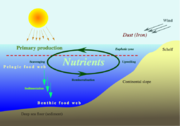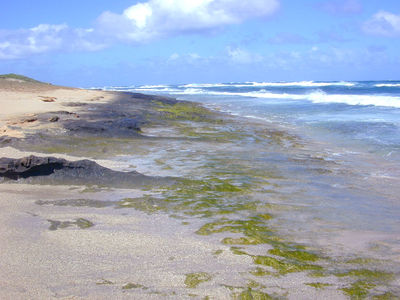Nutrient
2008/9 Schools Wikipedia Selection. Related subjects: Health and medicine
A nutrient is food or chemicals that an organism needs to live and grow or a substance used in an organism's metabolism which must be taken in from its environment. Non-autotrophic organisms typically acquire nutrients by the ingestion of foods. Methods for nutrient intake vary, with animals and protists having an internal digestive system, but plants externally digesting nutrients before ingesting them. The effects of nutrients are dose-dependent.
Organic nutrients include carbohydrates, fats, proteins (or their building blocks, amino acids), and vitamins. Inorganic chemical compounds such as minerals; water and oxygen may also be considered nutrients. A nutrient is essential to an organism if it cannot be synthesized by the organism in sufficient quantities and must be obtained from an external source. Nutrients needed in relatively large quantities are called macronutrients and those needed in relatively small quantities are called micronutrients.
See healthy diet for more information on the role of nutrients in human nutrition.
Types of nutrient
Macronutrients are defined in several different ways.
- The chemical elements humans consume in the largest quantities are carbon, hydrogen, nitrogen, oxygen, phosphorus, and sulfur.
- The classes of chemical compounds humans consume in the largest quantities and which provide bulk energy are carbohydrates, proteins, and fats. Water and atmospheric oxygen also must be consumed in large quantities, but are not always considered "food" or "nutrients".
- Calcium, salt (sodium and chloride), magnesium, and potassium (along with phosphorus and sulfur) are sometimes added to the list of macronutrients because they are required in relatively large quantities compared to other vitamins and minerals. They are sometimes referred to as the macrominerals.
The remaining vitamins, minerals, or elements, are called micronutrients because they are required in relatively small quantities.
Substances that provide energy
- Carbohydrates are compounds made up of sugars. Carbohydrates are classified by their number of sugar units: monosaccharides (such as glucose and fructose), disaccharides (such as sucrose and lactose), oligosaccharides, and polysaccharides (such as starch, glycogen, and cellulose).
- Proteins are organic compounds that consists of the amino acids joined by peptide bonds. The body cannot manufacture some of the amino acids (termed essential amino acids); the diet must supply these. In nutrition, proteins are broken down through digestion by proteases back into free amino acids.
- Fats consist of a glycerin molecule with three fatty acids attached. Fatty acids are unbranched hydrocarbon chains, connected by single bonds alone ( saturated fatty acids) or by both double and single bonds ( unsaturated fatty acids). Fats are needed to keep cell membranes functioning properly, to insulate body organs against shock, to keep body temperature stable, and to maintain healthy skin and hair. The body does not manufacture certain fatty acids (termed essential fatty acids) and the diet must supply these.
Fat has an energy content of 9 kcal/g (~37.7 kJ/g); proteins and carbohydrates 4 kcal/g (~16.7 kJ/g). Ethanol (grain alcohol) has an energy content of 7 kcal/g (~29.3 kJ/g).
Substances that support metabolism
- Dietary minerals are generally trace elements, salts, or ions such as copper and iron. Some of these minerals are essential to human metabolism.
- Vitamins are organic compounds essential to the body. They usually act as coenzymes or cofactors for various proteins in the body.
- Water is an essential nutrient and is the solvent in which all the chemical reactions of life take place.
Nutrients and plants
The chemical elements consumed in the greatest quantities by plants are carbon, hydrogen, and oxygen. These are present in the environment in the form of water and carbon dioxide; energy is provided by sunlight. Nitrogen, phosphorus, potassium, and sulfur are also needed in relatively large quantities. Together, these are the elemental macronutrients for plants, often represented by the acronym CHNOPS. Usually they are sourced from inorganic (e.g. carbon dioxide, water, nitrate, phosphate, sulfate) or organic (e.g. carbohydrates, lipids, proteins) compounds, although elemental diatomic molecules of nitrogen and (especially) oxygen are often used.
Other chemical elements are also necessary to carry out various life processes and build structures; see fertilizer and micronutrient for more information.
Some of these are considered macronutrients in certain organisms. The acronym C. HOPKiN'S CaFe Mg (to be used as C. Hopkins coffee mug) is used by some students to remember the list as: Carbon, Hydrogen, Oxygen, Phosphorus, Potassium (K), Nitrogen, Sulfur, Calcium, Iron (Fe), and Magnesium (Mg). Silicon, chloride, sodium, copper, zinc, and molybdenum are sometimes also included, but are in other cases considered micronutrients.
Oversupply of plant nutrients in the environment can cause excessive plant and algae growth. Eutrophication, as this process is called, may cause imblances in population numbers and other nutrients that can be harmful to certain species. For example, an algal bloom can deplete the oxygen available for fish to breathe. Causes include water pollution from sewage or runoff from farms (carrying excess agricultural fertilizer). Nitrogen and phosphorus are most commonly the limiting factor in growth, and thus the most likely to trigger eutrophication when introduced artificially.
Essential and non-essential nutrients
Nutrients are frequently categorized as essential or nonessential. Essential nutrients are unable to be synthesized internally (either at all, or in sufficient quantities), and so must be consumed by an organism from its environment.
For humans, these include essential fatty acids, essential amino acids, vitamins, and certain dietary minerals. Oxygen and water are also essential for human survival, but are generally not considered "food" when consumed in isolation.
Humans can derive energy from a wide variety of fats, carbohydrates, proteins, and ethanol, and can synthesize other needed amnio acids from the essential nutrients.
Non-essential nutrients can still have a significant impact on health, whether beneficial or toxic. For example, most dietary fibre is not absorbed by the human digestive tract, but is important in digestion and absorption of otherwise harmful substances. Interest has recently increased in phytochemicals, which include many non-essential nutrients which may have health benefits.

